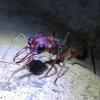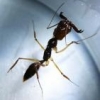and then, you know, release the ant into the wild. After all, it's not like we've created an ecologically destructive species. It's not like it'll outcompete other species or anything.
It's the same thing as releasing a collie, pug, bloodhound, or chihuahua into the wild. When things are selectively bred in captivity, they get very good at being domesticated at the cost of suppressing, damaging, or losing key survival genes. Find me one example of selective breeding causing "an ecologically destructive species"! That doesn't make sense. It doesn't make sense because the ancestor has all of your genes already. If they're not expressed in the wild, that's because nature has forced them to be recessive. You don't add DNA through selective breeding. If anything, you diminish and damage it.
I think the opposite problem might be more concerning. Imagine what an ant species bred to reproduce readily and thrive in captivity would do if it got loose in your house. It'd be quite the pest I imagine. It's even more worrying when you think about it being derived from fire ants.
That said, I don't think ants are a very good subject for selective breeding. Not only are their "generations" significantly longer than most insects, even many mammals, but their eusociality will make it very hard to isolate traits or specific behavior. However, even if you don't have any success with that, it sounds like more information on artificially encouraging ants to mate would be helpful to the community.



















